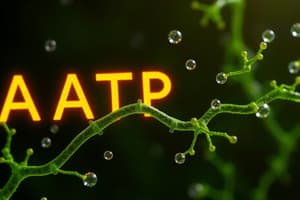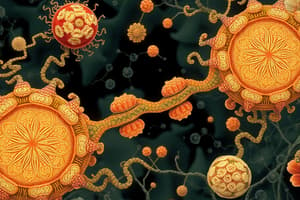Podcast
Questions and Answers
The collision theory states that chemical reactions can occur when atoms, ions, and molecules collide.
The collision theory states that chemical reactions can occur when atoms, ions, and molecules collide.
True (A)
Catabolism is the breakdown of complex molecules.
Catabolism is the breakdown of complex molecules.
True (A)
Anabolism is an exergonic process because it releases energy.
Anabolism is an exergonic process because it releases energy.
False (B)
Enzymes are encoded by genes.
Enzymes are encoded by genes.
A metabolic pathway can be defined as a sequence of chemical reactions that are catalyzed by enzymes.
A metabolic pathway can be defined as a sequence of chemical reactions that are catalyzed by enzymes.
An increase in temperature can increase the rate of a chemical reaction, according to the collision theory.
An increase in temperature can increase the rate of a chemical reaction, according to the collision theory.
Metabolism involves both the buildup and breakdown of nutrients within a cell.
Metabolism involves both the buildup and breakdown of nutrients within a cell.
Microorganisms are responsible for food spoilage.
Microorganisms are responsible for food spoilage.
All microbial metabolic pathways are pathogenic.
All microbial metabolic pathways are pathogenic.
Dental plaque consists entirely of bacteria.
Dental plaque consists entirely of bacteria.
Catalysts are biological substances that speed up chemical reactions.
Catalysts are biological substances that speed up chemical reactions.
Enzymes lower the activation energy of a reaction.
Enzymes lower the activation energy of a reaction.
The substrate is transformed and rearranged into products, which are then released from the enzyme in an unchanged form.
The substrate is transformed and rearranged into products, which are then released from the enzyme in an unchanged form.
Enzymes have a specific active site that binds to a specific substrate.
Enzymes have a specific active site that binds to a specific substrate.
Enzymes can convert a maximum of 10,000 substrate molecules per second.
Enzymes can convert a maximum of 10,000 substrate molecules per second.
The name of an enzyme usually ends in -ase.
The name of an enzyme usually ends in -ase.
A lyase is an enzyme that catalyzes the removal of atoms without hydrolysis.
A lyase is an enzyme that catalyzes the removal of atoms without hydrolysis.
A holoenzyme is a protein that requires a cofactor for activity.
A holoenzyme is a protein that requires a cofactor for activity.
Temperature has no effect on enzyme activity.
Temperature has no effect on enzyme activity.
The rate of an enzymatic reaction is proportional to the amount of enzyme present.
The rate of an enzymatic reaction is proportional to the amount of enzyme present.
Enzymatic activity always increases when the temperature is increased.
Enzymatic activity always increases when the temperature is increased.
Competitive inhibitors bind to the active site of an enzyme.
Competitive inhibitors bind to the active site of an enzyme.
Enzymes can be denatured by heat.
Enzymes can be denatured by heat.
The optimal pH for an enzyme is always pH 7.
The optimal pH for an enzyme is always pH 7.
Feedback inhibition is an example of allosteric regulation of an enzyme.
Feedback inhibition is an example of allosteric regulation of an enzyme.
Enzymes increase the rate of reaction by lowering the activation energy.
Enzymes increase the rate of reaction by lowering the activation energy.
A ribozyme is an RNA molecule that functions as a catalyst.
A ribozyme is an RNA molecule that functions as a catalyst.
The substrate concentration does not affect the rate of a reaction.
The substrate concentration does not affect the rate of a reaction.
Allosteric inhibition involves the binding of an inhibitor to the active site of an enzyme.
Allosteric inhibition involves the binding of an inhibitor to the active site of an enzyme.
Flashcards
Metabolism
Metabolism
The buildup and breakdown of nutrients within a cell, involving chemical reactions that provide energy and sustain life.
Catabolic Reactions
Catabolic Reactions
Reactions that break down complex molecules to provide energy and building blocks for anabolism; they are exergonic.
Anabolic Reactions
Anabolic Reactions
Reactions that use energy and building blocks to build complex molecules; they are endergonic.
Metabolic Pathways
Metabolic Pathways
Signup and view all the flashcards
Collision Theory
Collision Theory
Signup and view all the flashcards
Activation Energy
Activation Energy
Signup and view all the flashcards
Reaction Rate
Reaction Rate
Signup and view all the flashcards
Exergonic Reactions
Exergonic Reactions
Signup and view all the flashcards
Endergonic Reactions
Endergonic Reactions
Signup and view all the flashcards
Enzymes
Enzymes
Signup and view all the flashcards
Catalyst
Catalyst
Signup and view all the flashcards
Substrate
Substrate
Signup and view all the flashcards
Enzyme-substrate complex
Enzyme-substrate complex
Signup and view all the flashcards
Turnover number
Turnover number
Signup and view all the flashcards
Enzyme specificity
Enzyme specificity
Signup and view all the flashcards
Denaturation
Denaturation
Signup and view all the flashcards
Factors influencing enzyme activity
Factors influencing enzyme activity
Signup and view all the flashcards
Naming enzymes
Naming enzymes
Signup and view all the flashcards
Enzymatic Activity
Enzymatic Activity
Signup and view all the flashcards
Optimal pH
Optimal pH
Signup and view all the flashcards
Substrate Concentration
Substrate Concentration
Signup and view all the flashcards
Competitive Inhibitors
Competitive Inhibitors
Signup and view all the flashcards
Noncompetitive Inhibitors
Noncompetitive Inhibitors
Signup and view all the flashcards
Allosteric Inhibition
Allosteric Inhibition
Signup and view all the flashcards
Feedback Inhibition
Feedback Inhibition
Signup and view all the flashcards
Active Site
Active Site
Signup and view all the flashcards
Ribozymes
Ribozymes
Signup and view all the flashcards
Study Notes
Microbial Metabolism
- Metabolism is the buildup and breakdown of nutrients within a cell
- These chemical reactions provide energy and create substances that sustain life.
Dental Plaque
- Dental plaque consists of bacteria.
Catabolic and Anabolic Pathways
- Catabolic pathways break down macromolecules into simpler components, releasing energy.
- Anabolic pathways build up macromolecules by combining simpler molecules, using energy in the process.
- Catabolic and anabolic pathways are linked by energy. Catabolic reactions provide energy for anabolic reactions.
- These processes are linked to the energy storage/release of ATP (adenosine triphosphate).
Microbial Metabolism and Disease
- Although microbial metabolism can cause disease and food spoilage, many pathways are beneficial, not pathogenic.
Enzymes and Chemical Reactions
- Catalysts speed up chemical reactions without being altered.
- Enzymes are biological catalysts.
- Enzymes act on specific substrates, lowering activation energy.
- Substrate contacts the enzyme's active site to form an enzyme-substrate complex.
- Substrate is transformed and rearranged into products, released from the enzyme.
- The enzyme is unchanged and can react with other substrates.
Enzyme Mechanisms
- The images provide a graphical visualization of the enzyme mechanism.
Enzyme Specificity and Efficiency
- Enzymes have specificity for specific substrates.
- Turnover number is the number of substrate molecules an enzyme converts to a product per second (generally 1 to 10,000).
Enzyme Names
- Enzyme names usually end in "-ase" and are grouped based on the reaction they catalyze.
- Examples include: oxidoreductase (oxidation-reduction), transferase (transfer functional groups), hydrolase (hydrolysis), lyase (removal of atoms without hydrolysis), isomerase (rearrangement of atoms), and ligase (joining of molecules; uses ATP).
Holoenzymes
- Holoenzyme, the whole enzyme, consists of an apoenzyme (inactive protein portion) and a cofactor (nonprotein activator).
- Coenzymes are a type of cofactor.
Factors Influencing Enzyme Activity
- Temperature: High temperatures denature proteins, affecting enzyme activity. Ideal temperatures exist for most enzymatic reactions.
- pH: Extreme pH values also denature proteins in enzymes. Ideal pH values exist for optimal enzyme activity.
- Substrate Concentration: Increasing substrate concentration increases reaction rates up to a point where all active sites are saturated.
- Inhibitors: Substances that reduce enzyme activity.
- Competitive inhibitors: Fill the active site, competing with the substrate.
- Noncompetitive inhibitors: Interact elsewhere on the enzyme (allosteric site), changing the active site's shape.
Feedback Inhibition
- The end-product of a reaction allosterically inhibits enzymes earlier in the pathway.
- It's a regulatory mechanism to control the amount of product.
Ribozymes
- RNA that function as catalysts, cutting and splicing RNA.
Studying That Suits You
Use AI to generate personalized quizzes and flashcards to suit your learning preferences.




